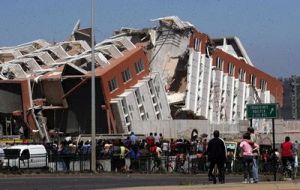MercoPress. South Atlantic News Agency
Reconstruction efforts will turn Chile from capital exporter to importer, says IIF
 The cost of the earthquake and tsunami is estimated in 29.7 billion USD
The cost of the earthquake and tsunami is estimated in 29.7 billion USD Increased external financing requirements to cover reconstruction costs triggered by the earthquake and tsunami of February 27 will shift Chile’s external position from capital exporter in 2009 (largely the result of its dynamic private pension system) to capital importer this year and next, according to the Institute of International Finance, IIF.
The cost of this natural catastrophe, estimated at 29.7 billion (18% of GDP) by the Chilean government, splits evenly between the public and private sectors, and is to be absorbed over the next three-four years.
The catastrophe has raised the financing requirements of the public sector by 9.3 billion (5.7% of GDP) for 2010¬2013. Financing needs, however, are likely to be higher in 2010 and 2011 as the bulk of reconstruction effort is to be carried out during these years.
Notwithstanding copper savings for 11.3 billion (7% of GDP) in the Economic and Social Stabilization Fund (ESSF), the financing mix chosen by the government is likely to limit ESSF withdrawals, with judicious reliance on the deep local bond market to finance part of the reconstruction through peso debt issuance. This is partly to avoid a disruptive sharp currency appreciation. The public financing mix is also likely to include expenditure reallocation, sale of assets and a selective increase of taxes.
While implementation of a balanced financing mix will allow rebuilding the economy’s productive capacity without compromising stability, IIF expects this catastrophe to have the following impact on the balance of payments:
Shift the current account into deficit: Despite a higher price of copper, which account for half of total exports, IFF expects a surge in imports to shift the current account from a surplus of 2.6% of GDP in 2009 to a small deficit this year. The catastrophe is set to boost imports of machinery and equipment and other industrial goods needed to substitute a temporary decline in national production.
Repatriation of ESSF funds: IFF expect earthquake-related capital repatriation of ESSF foreign currency savings of 1 to 1.5 billion USD this year.
A surge in net private capital inflows: Two factors will boost private inflows this year. First the sovereign is likely to issue a long-term global bond for about 1 billion as part of its reconstruction financing mix in order to provide a benchmark for potential borrowing by private corporations and secondly, substantial capital transfers stemming from reinsurance claims (in accordance with IMF guidelines, these payments are accounted for in the capital account).
Including claims for damaged productive capital stock as well as for lost profits, reinsurance inflows are estimated to be in the range of 5 to 8 billion USD.




Top Comments
Disclaimer & comment rules-

Read all commentsThanks to the rule of law and stability, they can handle the swings in the economy... lower graft and live better.
Apr 19th, 2010 - 07:14 am 0Commenting for this story is now closed.
If you have a Facebook account, become a fan and comment on our Facebook Page!